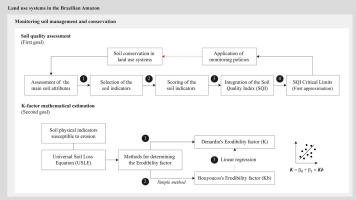巴西亚马逊土地利用系统中土壤质量临界值的初步近似值
IF 5.4
1区 农林科学
Q1 GEOSCIENCES, MULTIDISCIPLINARY
引用次数: 0
摘要
土壤质量研究作为一种评估工具,有助于土壤管理和指导土地使用决策。我们开发并评估了巴西亚马逊地区土地利用系统的土壤质量指数(SQI),并初步确定了土壤质量的临界极限。此外,我们还提出了一个等式,以更简单易行的方法确定德纳丁侵蚀系数。我们对来自五个土地利用系统(LUS)的 225 个土壤样本(0-20 厘米深)进行了 21 项物理、化学和生物分析。我们使用两个数据集(总数据集和最小数据集)、两种评分方法(线性评分法和非线性评分法)和三种 SQI 整合方法(加法、加权加法和 Nemoro)对 12 个 SQI 进行了整合和比较。结果表明,在所有 LUS 中,使用最小数据集和线性计分法的加权 SQI 是最显著和最佳的土壤指标整合方法。只有最小数据集中的粘土含量和德纳丁侵蚀性因子与加性 SQI 有显著的线性回归和较高的决定系数(r2 > 0.50, P <0.05)。据此,我们确定了每个 LUS 的 SQI 临界值。诊断土壤质量低的粘土含量临界值分别为:农林系统 225.28 和 171.89 g kg-1,林牧系统 210.74 g kg-1,牧场系统 201.23 g kg-1,天然林 198.29 g kg-1。只有在林牧系统、天然林系统和牧场系统中,土壤质量低的侵蚀临界值分别为 0.0657、0.0656 和 0.0596 t h MJ-1 mm-1。这些研究结果表明,牧场系统和天然林系统的土壤容易受到人为土壤退化的影响,因为它们在可蚀性因子和土壤质量临界值之间呈现陡峭的线性斜坡。在这些 LUS 中,我们发现了用于确定 Erodibility 因子的重要且数学上合理的线性回归方程。本文章由计算机程序翻译,如有差异,请以英文原文为准。

First approximation of soil quality critical limits in land use systems in the Brazilian Amazon
Soil quality study as an assessment tool can contribute to soil management and guide land use decisions. We developed and evaluated soil quality indices (SQI) for land use systems in the Brazilian Amazon and identified the critical limits of soil quality as a first approximation. Additionally, we proposed an equation to determine Denardin’s Erodibility factor by a simpler and accessible method. We performed 21 physical, chemical, and biological analyses of 225 soil samples (0–20 cm depth) from five land use systems (LUS). We integrated and compared 12 SQIs using two data sets (total and minimum), two scoring methods (linear and non-linear), and three SQI integration approaches (Additive, Weighted additive, and Nemoro). The results indicate that in all LUSs, the most significant and best-estimated integration of soil indicators was the Additive SQI using the minimum data set and linear scoring method. Only clay content and Denardin’s Erodibility factor from the minimum data set showed significant linear regressions and high coefficients of determination (r2 > 0.50, P < 0.05) with the Additive SQI. According to them, we determined the critical limits of the SQI in each LUS. Clay content threshold values to diagnose low soil quality were 225.28 and 171.89 g kg−1 for the Agroforestry Systems, 210.74 g kg−1 for the Silvopastoral System, 201.23 g kg−1 for the Pasture System, and 198.29 g kg−1 for Natural Forest. Erodibility threshold values to diagnose low soil quality were 0.0657, 0.0656, and 0.0596 t h MJ−1 mm−1 only for the Silvopastoral, Natural Forest, and Pasture systems, respectively. These findings suggest that the soils from the Pasture System and Natural Forest are vulnerable to anthropogenic soil degradation because they present steep linear slopes between the Erodibility factor and the soil quality critical limits. In these LUSs, we identified significant and mathematically plausible linear regression equations for determining Erodibility factor.
求助全文
通过发布文献求助,成功后即可免费获取论文全文。
去求助
来源期刊

Catena
环境科学-地球科学综合
CiteScore
10.50
自引率
9.70%
发文量
816
审稿时长
54 days
期刊介绍:
Catena publishes papers describing original field and laboratory investigations and reviews on geoecology and landscape evolution with emphasis on interdisciplinary aspects of soil science, hydrology and geomorphology. It aims to disseminate new knowledge and foster better understanding of the physical environment, of evolutionary sequences that have resulted in past and current landscapes, and of the natural processes that are likely to determine the fate of our terrestrial environment.
Papers within any one of the above topics are welcome provided they are of sufficiently wide interest and relevance.
 求助内容:
求助内容: 应助结果提醒方式:
应助结果提醒方式:


